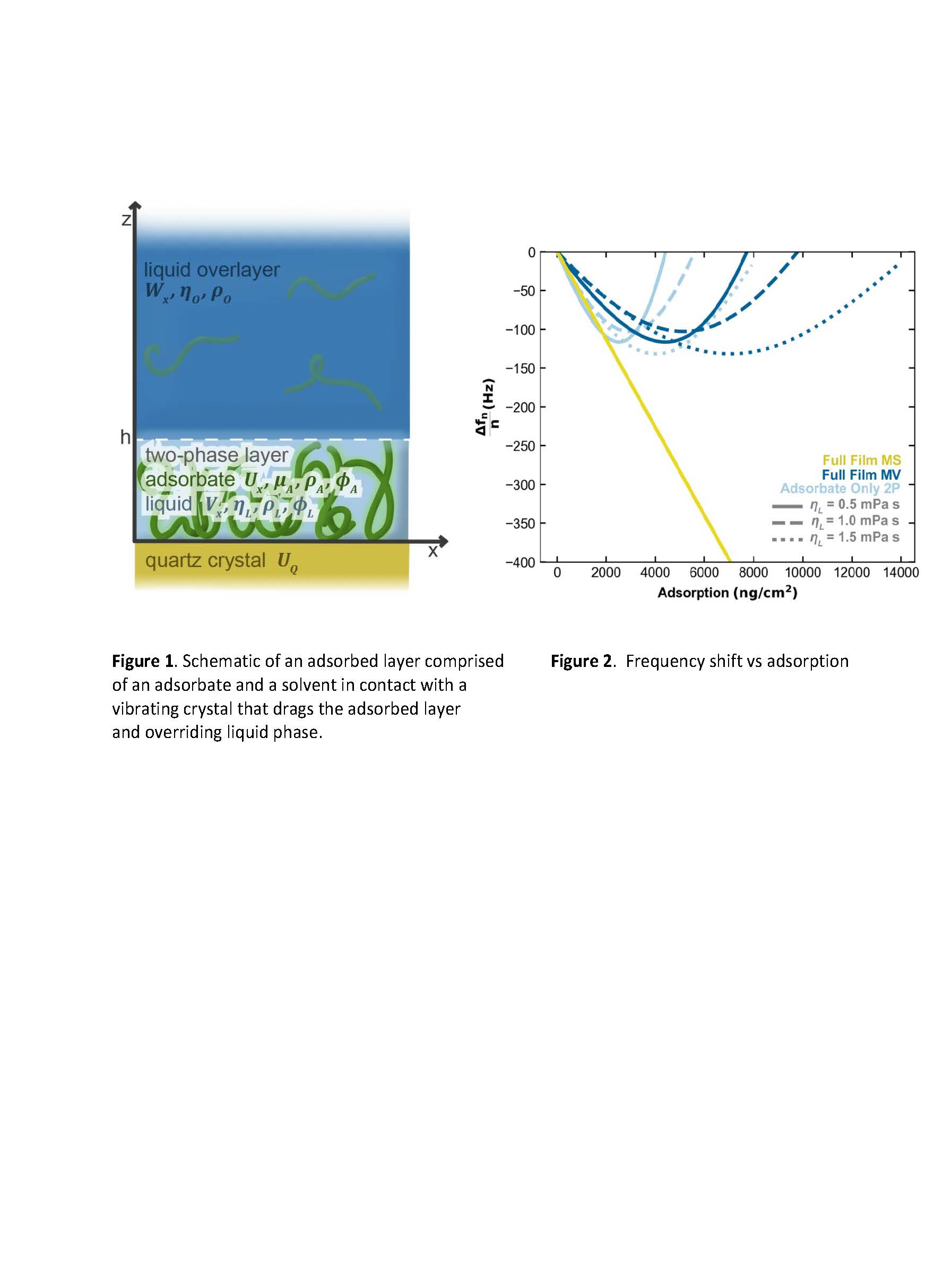2022 Annual Meeting
(440e) A Two-Phase Model for Adsorption from Solution Using Quartz Crystal Microbalance with Dissipation
Authors
A hydrodynamic model is required to convert measured QCM-D signals of frequency shift (and dissipation (D) into film areal mass (), shear modulus (), and shear viscosity (). The two most common models are those of Sauerbrey1 (derived for an oscillator with a thin rigid film in a vacuum) and Voinova et al.2 (derived for a viscoelastic adlayer characterized by a sequence of Kelvin-Voigt films and covered by a Newtonian viscous fluid). However, in applications dealing with adsorption from solution, both the Sauerbrey and Voinova et al. models use a homogeneous-solution approximation for the adlayer film. Unfortunately, in solution adsorption, the adlayer consists of adsorbent-attached molecules/particles penetrating into the solvent, as illustrated in Figure 1. Because adsorbate molecules stick to the adsorbent surface, they do not mix homogeneously with the liquid solvent. Consequently, the imposed oscillatory flow is not that of a locally homogenous-composition liquid mixture. Rather fixed adsorbate molecules are periodically dragged and stretched by flowing solvent during crystal oscillation. Simple application of a no-slip boundary condition at the oscillating solid surface does not guarantee that extended portions of adsorbate molecules remain fixed to the adsorbent surface.
Additionally, for all in situ solution-adsorption studies, the adlayer is composed of both solvent and adsorbate-phase fractions. Solvent flows around adsorbate molecules, especially at low coverage, and possibly even seeps through tethered adsorbate meshes, but is not strictly âadsorbedâ. When the Sauerbrey or Voinova et al. models are applied to these systems, adlayer mass includes both that of the adsorbate and the solvent. Consequently, adsorbate mass is overpredicted because solvent mass is counted as part of the adlayer. Moreover, some of the force signal is due to frictional forces between the two phases, and cannot all be attributed to the adsorbed mass.
To solve rigorously for the shear force on the crystal due to the adlayer and to expose the effects of an adlayer consisting of a liquid solvent and a bound adsorbate phase, we solve two momentum balances simultaneously. The geometry of the system under consideration is pictured in Figure 1. An adsorbed molecular/particle layer is in contact with a mineral-coated quartz-crystal substrate at oscillating at a velocity . For illustrative purposes only, the adsorbed layer is comprised of loop-and-train adsorbed molecules around and possibly through which a Newtonian viscous solvent flows. We emphasize that the governing equations are agnostic to detailed adsorbate conformations provided that the adsorbate molecules do not detach under solvent shear. Many molecular geometries beyond loop and train are possible. Friction from liquid-solvent flow in the adlayer periodically distorts the adsorbed phase characterized by an elastic response. The adsorbed layer has a thickness defined by the extent of the adsorbed molecules.
Transient differential momentum balances are written on the flowing liquid and on the translating adsorbate phase including friction between the two phases quantified by a friction coefficient ζ. The important boundary condition is continuity of stress between the adlayer, treated analogously to a porous medium, and the overlaying Newtonian liquid. We adopt the shear-continuity formulation of Neale and Nader at adlayer height consistent with Brinkman flow.3 Liquid-phase volume fraction in the adlayer refers only to free flowing liquid. Solvent bound to the adsorbate molecules translates with the adsorbate and is not part of the flowing-liquid volume fraction. Thus, adsorbate molecules and bound non-draining solvent molecules define the adsorbate-phase volume fraction.
The momentum balances are solved in periodic oscillatory flow and converted to frequency shift and dissipation signals. Figure 2 gives example calculated frequency shifts as a function of adsorbed amount for three different models of the adlayer: Sauerbrey (MS), Voinova et al. (MV) and proposed two-phase (2P). Note the large discrepancies between the models and both MS and MV overestimation of adsorbed amounts.
Current QCM-D homogeneous-film models do not capture the physics of solution adsorption and they overestimate adsorbate-phase mass due to the inclusion of flowing fluid in the adlayer. Distinguishing between adsorbate adsorption and homogeneous-film adsorption is critical; failing to do so leads to incorrect adlayer mass and physical properties. The proposed 2P model rigorously treats the physics of the adlayer including friction between the surface-attached adsorbate-phase molecules and flowing solvent, and self-consistently corrects for flowing solvent inclusion in the adlayer. The two-phase model presented here applies to a vast number of adsorption scenarios across many fields; it provides a currently unavailable tool to interpret QCM-D solution-adsorption data.
References
- Sauerbrey, G., Verwendung von Schwingquarzen zur Wägung dünner Schichten und zur Mikrowägung. Zeitschrift für Physik 1959, 155 (2), 206-222.
- Voinova, M. V.; Rodahl, M.; Jonson, M.; Kasemo, B., Viscoelastic Acoustic Response of Layered Polymer Films at Fluid-Solid Interfaces: Continuum Mechanics Approach. Physica Scripta 1999, 59 (5), 391-396.
- Neale, G.; Nader, W., Practical significance of brinkman's extension of darcy's law: Coupled parallel flows within a channel and a bounding porous medium. The Canadian Journal of Chemical Engineering 1974, 52 (4), 475-478.

